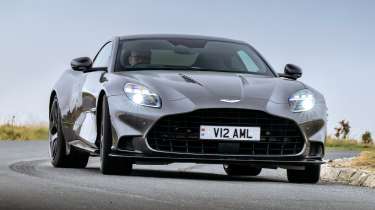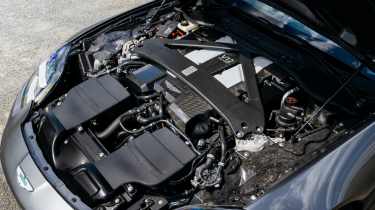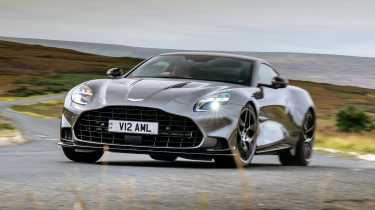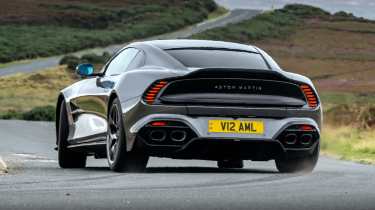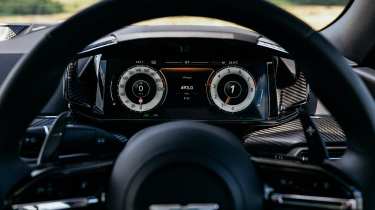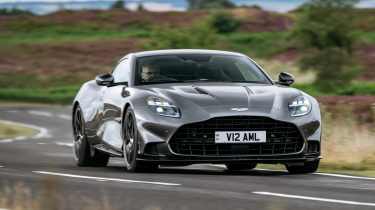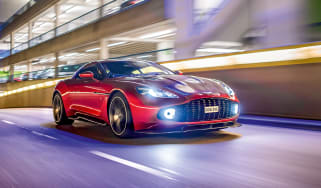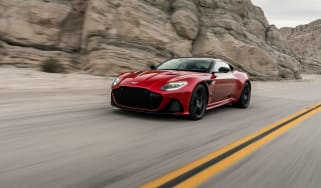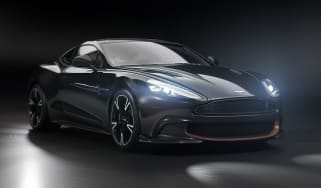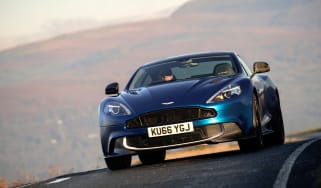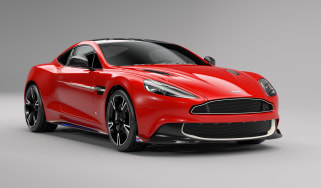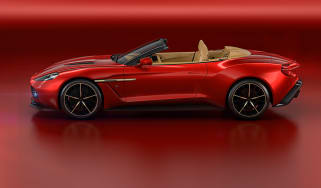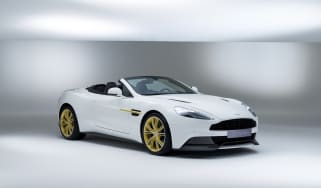Aston Martin Vanquish 2025 review - Britain’s Ferrari 12 Cilindri rival
The third-generation Aston Martin Vanquish is not only the best yet, it’s the best Aston Martin full stop
After all of the chat – the technical insights, the design philosophy, the shaping of the dynamic character, et cetera – after all of that, there’s unvarnished reality and your unfiltered response to it. The first Vanquish I laid eyes on was outside the entrance of the launch hotel and it wowed me. In metallic red with gold wheels, it looked sensational: low, long, beautifully sculpted. For me, without hesitation, it’s the best looking Aston Martin in 25 years. A great start.
The shape looks fabulous, quietly aggressive. Dropping into the driver’s seat, the cabin exudes simple class, the V12 just loud enough. Then, before we’d left the hotel grounds there was a strong hint that it was going to deliver dynamically, because it tackled the speed humps with the suppleness of a proper GT.
The new Vanquish needs to hit the ground running because Ferrari’s 12 Cilindri targets the same buyers and has uncannily similar headline stats. We’ll get the pair together soon enough, but in the meantime, here’s how the Vanquish fares in isolation.
Engine, gearbox and technical highlights
- Massive power and torque from twin-turbo V12
- More vocal than the Ferrari 12 Cilindri
- Aluminium chassis, some carbon panels
The Vanquish uses an all-new 5.2-litre V12 – five years in the making with a Covid-related delay. Literally everything is new and optimised for efficiency and power – the cylinder block, the heads, the reprofiled camshafts, the combustion chamber design, the intake and exhaust, the higher pressure injection system, even the turbos, which are the same size but have less inertia and are faster responding and higher revving. Homologating an all-new V12 to global emissions standards with the ban on pure ICE cars looming is not the work of a moment.
Power and torque are not in short supply: 824bhp is the headline figure (214mph and 0-62mph in 3.3 seconds being the other big numbers), while torque is a massive 737lb ft at 2500rpm, comfortably out-punching the conceptually similar Ferrari 12Cilindri.
More reviews
In-depth reviews
Reviews
- Aston Martin Vanquish Volante 2025 review – Ferrari 12 Cilindri Spider rival impresses
- Aston Martin Vanquish (2012 - 2018, Mk2): a V12 super GT great
- Aston Martin Callum Vanquish 25 by R-Reforged 2022 review
- 2019 Aston Martin Vanquish Zagato Shooting Brake review
- Aston Martin Vanquish Zagato review
- Aston Martin Vanquish S review - should you buy one over a DB11?
Meanwhile, the bonded aluminium chassis has been extended by 80mm between the A-pillar and front axle line, which, along with an increase in overall length of 135mm, helps give the new car its long, lithe profile. The front and rear tracks have been widened, by 15mm and 25mm respectively, and there’s a new front crossmember and strut-brace to help increase lateral stiffness by 75 per cent. Suspension attachment points have been beefed up and there’s a solidly mounted steering column for better steering fidelity, particularly on-centre but in transient manoeuvres and at high speed too.
Unstressed body panels are fabricated from carbonfibre rather than the pressed aluminium saving 40 per cent in material weight and on tooling, too, with Aston committed to building no more than 1000 per year. A closer look reveals that there are quite a few naked carbon bits, notably the roof with its neat swage-lines and the panel between the tiered rear light units that Aston calls the ‘shield’, plus the mirrors and various addenda such as the front splitter, the rear diffuser and the bonnet vents, which help relieve high pressure in the engine bay. Increasing in size and packed with more technology, including ADAS devices, the claimed kerb weight has increased by 65kg to 1835kg.
Best supercars 2025 – our favourite show-stopping driving machines
The tyres are enormous: 275/35 ZR21 front and 325/30 ZR21 rear, Pirelli P Zeros, AML spec, of course, and preferred over a Michelin for its naturally more absorbent sidewall and Pirelli’s Noise Cancelling System (PNCS) – a series of foam pads bonded to the tyre inner. The tyres are mounted on lovely, thin-sparred wheels, the structure of which has been optimised using computer simulation to remove excess weight (they’re lighter than any previous 21-inch Aston wheel). Standard-fit carbon-ceramic brakes, massive 410mm discs on the front, 360mm on the rear, save a 27kg versus an iron/steel set-up.
Suspension is by double wishbones at the front and multi-link at the rear, with Bilstein DTX damper technology to deliver a supple secondary ride and strong primary control. Larger diameter anti-roll bars increase roll stiffness, and the final piece of the dynamic control hardware is the first deployment of an e‑diff on a V12 Aston. Unlike a conventional mechanical locking diff, an e‑diff can be open, locked or anything in between in a few milliseconds, offering more opportunity to influence agility and traction.
Performance, ride and handling
- Enormous, never-ending reserves of performance
- Tactile and well-balanced handling
- Fabulous as a grand-tourer
The steering efforts are a fraction high, but once you’re into the swing of a few corners, it feels spot on. In fact, GT mode is really well judged and you could leave it there forever and the Vanquish would do everything you wanted it to with aplomb. There’s a really natural, linear feel to the steering, you get a good sense of what’s going on at the front and the car feels well balanced and agile. It’s keen to turn, and you can be really accurate with it. Its response to inputs is more measured and natural than other recent Astons, so on a winding road you know where you are with it. Consequently, you quickly get into a flow and find a satisfying rhythm. Of course, it’s absolutely ballistic if you want it to be, but it does the comfortable lope too.
In auto the eight-speed ZF auto finds the optimum gear smoothly and quickly and manages the 737lb ft of torque; which be the limit for the ’box because in both cars the shift speed is no faster in the sportier settings (in the Vanquish that’s Sport and Sport+). Not that this is much of an inconvenience. In fact, it’s such a great sounding engine that you want to hear it working through the revs, so select manual, use the paddles and enjoy the feeling and sound of the V12 getting its shoulder behind the mass of the Vanquish. Despite the weight, it’s not long before the V12 is reeling in the horizon, its note guttural at first then a glorious howl.
> Best British cars – the finest driver’s cars to come out of Great Britain
On the move it’s plenty fast enough in GT, but ramp things up to Sport or Sport+ and the throttle response is stronger, the performance harder-edged and more insistent. The whole car tenses up slightly and there’s always a slug of instant urge when you crack open the throttle. The credit isn’t all down to the lighter, faster-accelerating turbos; the Vanquish has ‘boost reserve’, a system that anticipates throttle demand and on part-throttle builds boost in readiness for the next request, thereby giving crisper response. And while boost reserve may win back fractions of a second in response that would otherwise be lost, in the grand scheme I think it matters not.
The scale of performance in the Vanquish is so epic, so monumental, it’s almost irrelevant. Find a decent straight, nail it and hear the V12 roar as it accelerates with such solid determination that it feels like it’s going to keep piling on the speed at an unabated rate until you run out of nerve, or road, or hit 214mph.
Dynamically, the Vanquish is pretty well balanced, its static distribution split 51:49 front-to-rear. Attack a corner and you get the sense of how hard each axle is working through the steering wheel and the seat of your pants, so you can predict what will happen if you inject a chunk more power into the mix. You can also get a feel for how the car will behave unrestrained by disabling stability but using scalable traction control to creep up on the limit of rear grip. The Vanquish loads up evenly, more throttle will jink the tail out – what else? – but grip is exceeded and returns relatively easily for such a big, potent car. It all feels a bit academic, though, because there’s such a breadth of entertainment and satisfaction to be had without smoking the rear tyres.
> Used Aston Martin Vanquish (Mk1, 2001-2007): Britain's answer to the Ferrari 550 Maranello
It’s sharp, tactile and engaging when you want it to be, satisfying the super-GT part of the brief, and nails the pure GT part too, with a continent-crossing combination of supple low-speed ride, firm but comfortable seats, superb wind noise refinement and an outstanding sound system. The brakes are outstanding too, with a great sense of power and great feel. Downsides? High road noise, relative lack of space for such a big car, the odd bit of old switchgear and the tiny typeface in the HMI.
Driver’s note
‘Turbocharging really doesn’t detract from the V12’s spectacular voice, nor its responses. Like many Astons there’s a reassuringly weighty feel to the control weights, but this is matched by the car’s physical size – it’s certainly not a car that shrinks around you, so you need wide roads to really enjoy it.’ – Antony Ingram, evo contributing writer, who drove the Vanquish on UK roads
Interior and tech
- Quality, feel, and smell are all on-point
- TFT screens still a long way from the best
- Lovely details offset by some older switchgear
The dashboard design is familiar from DB12 and Vantage, which is great from a style perspective, not so great from an HMI angle because the typefaces used in the TFT screens are still way too small. Satin-finish carbon trim spans the facia, contrasting with the smooth leather, and further contrast is provided by the ‘parmesan grater’ grills for the multiple Bowers & Wilkins speakers.
There are some lovely touchpoints, including the stubby gear selector and the knurled rotary switches that sit either side. It’s a shame there are a few hangover bits from the DBS, such as the switches for the electric seats and door mirrors, as they do jar slightly. There are no rear seats this time but the rear buckets of the DBS were more ornamental than practical.
Price and rivals
Aston Martin’s new flagship costs from £334,000, a figure that cannot be taken lightly. It’s a significant sticker price for the British brand considering its financial performance post IPO, and some of the struggles dealers have with stock and how long it sticks around. It’s a challenge new CEO Adrian Hallmark is already addressing.
You might point out that Ferrari charges a similar amount for its new 12 Cilindri at £336,500 before you go anywhere near the options list, but Ferrari is Ferrari…
Aston Martin Vanquish specs
| Engine | V12, 5204cc |
|---|---|
| Power | 824 @ 6500rpm |
| Torque | 737lb ft @ 2500rpm |
| Weight | 1835kg (claimed) |
| 0-62mph | 3.3sec |
| Top speed | 214mph |
| Basic price | £334,000 |
